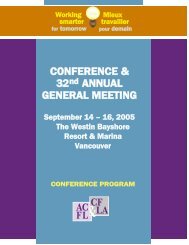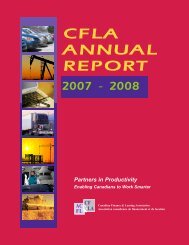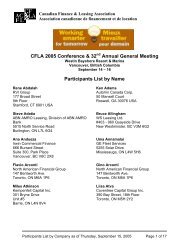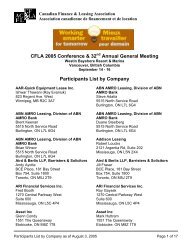Annual
LA - Canadian Finance & Leasing Association
LA - Canadian Finance & Leasing Association
- No tags were found...
Create successful ePaper yourself
Turn your PDF publications into a flip-book with our unique Google optimized e-Paper software.
CFLA ANNUAL REPORT 2003 - 2004<br />
The 2003-2004 Year<br />
Asset-based financing and leasing:<br />
a Canadian market overview<br />
INTRODUCTION<br />
In spite of economic and geo-political shocks including the War on Terrorism, SARS, BSE and the<br />
appreciation of the Canadian dollar, the Canadian leasing market enjoyed a rebound in 2003 after two<br />
years of declining activity. A modest recovery in machinery and equipment investment has raised<br />
business demand in Canada for equipment financing.<br />
Over the next two years (2004-2005), the outlook for the leasing industry on a growth basis is<br />
expected to be positive - although moderate by 1990s standards. The main factor in the outlook will<br />
be the impact of the US economic recovery on business investment decisions in Canada.<br />
The rapid consolidation within the industry appears complete – for now. Ongoing restructuring among<br />
the larger participants in the industry and legislative issues which affect all CFLA members continue<br />
to be relevant.<br />
The following provides a review of recent trends, the outlook for and highlights of major trends and<br />
issues in the leasing sector.<br />
REVIEW OF RECENT TRENDS<br />
In 2003, the Canadian economy had to contend with SARS, BSE (Mad Cow Disease) and a rapid<br />
appreciation of the Canadian dollar which combined to slow the economy to 2% growth. The absence<br />
of similar shocks and the strength of the US economy should help real GDP growth rebound to 2.8%<br />
in 2004. While this is good, it is substantially below the 4.8% growth expected for our major trading<br />
partner – the United States.<br />
The economy in 2003 was led by residential investment, government and household spending. The<br />
exception was the automotive sector. But despite a 6.2% decline, new vehicle sales remained strong at<br />
1.6 million units in 2003. Business investment finally started to rise again in 2003 - albeit only in<br />
inflation adjusted terms. The external sector slowed the economy as the rise in the value of the<br />
Canadian dollar led to lower exports coupled with higher imports.<br />
After a two year slump beginning in 2001, lessors finally reported rising demand for financing in<br />
2003. Although spending on capital equipment fell 1% or $0.9 billion in 2003 to $83.4 billion,<br />
equipment lessors new business rose by $1.8 billion (10.8% higher than in 2002).<br />
ECONOMIC AND CAPITAL INVESTMENT OUTLOOK 2004<br />
Canada's economic prospects are promising. Supported by strong global growth, the US economy is<br />
expected to grow by 4.5% in 2004; Canada is expected to grow 2.8% this year and 4.0% in 2005.<br />
Monetary policy is very supportive of growth, with the overnight rate well below a neutral setting.<br />
Given forecasts of strong growth, the Bank of Canada is widely expected to start increasing interest<br />
rates in the fourth quarter of 2004 and to continue raising them in 2005. While the Canadian dollar is<br />
10<br />
“Partners in Productivity”









